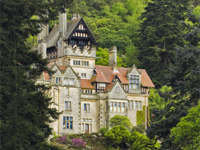
One hundred and fifty years ago, as 1863 drew to a close, the great industrialist Lord Armstrong may have reflected on a year in which innovation was sweeping across so many areas of life and, perhaps, his own future plans for his new country house at Cragside, Northumberland. Country houses have often been at the nexus of innovation as they contain just the right mix of elements; namely a fashion for novelty, complex issues to be solved and a desire to impress others, along with the resources to experiment. Cragside was to be a fine example of all these desires, a joint effort between an inventor owner and an inventive architect.
1863 was another year of great industrial developments as diverse as the running of the first Underground trains in London and the patenting of TNT, both of which would have far-reaching consequences. That driving spirit of creativity spurred the Victorian engineer to look at many challenges, both large and small, seeking solutions which provided greater utility and comfort, though often tempered by the conservatism or financial reluctance of the owner.
Comfort and luxury are not always as synonymous as they are today and tales are legion of freezing country houses where one bathroom (used only for bathing naturally) served a whole house. Owners of older aristocratic houses often felt little need to modernise; after all, if you had hot and cold running servants ferrying coal and water about the house this was often cheaper than a full refurbishment. Worse, such improvements might be seen as nouveaux-riche (and therefore vulgar), unhealthy, or, worse, American. By contrast, the new money aristocrats in the Victorian era often had worked their way from less distinguished backgrounds and were keen to use anything which provided a better life – and also gave them the social bragging rights of novelty.
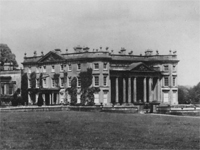
Open fires have been the mainstay of country houses for hundreds of years but central heating – either steam, hot air or hot water – started making a comeback in the late Georgian period (remember the Romans introduced it first). The library at Bowood House, Wiltshire was thought to be the first modern room to be centrally heated when it was introduced in the 1790s (although it wasn’t all that successful). Other centrally heated single rooms were to be found at Pakenham Hall, Co. Westmeath in 1807 where ‘The immense hall so well-warmed by hot air that the children play in it from morning to night‘. The first multi-room ducted hot-air arrangements could be found at Coleshill, Berkshire in 1814, and Abercairny, Perthshire in 1829. Steam proved difficult to control (though it was installed by Sir Walter Scott at Abbotsford in 1823) so other early examples were either hot air (Osmaston Manor – 1846-49, Flixton – 1847, or Tortworth Court – 1849-52) or hot water via radiators (Mentmore Towers – 1850-55). These systems rarely extended beyond the entrance areas, hallways and main downstairs rooms.
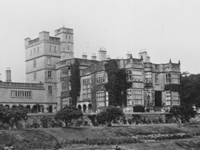
Ventilation was always a challenge and the unpleasant accumulation of stale air and the smell of gas was exacerbated by the higher building standards of the Victorians which reduced drafts. Many houses such as Kelham Hall, Mentmore, Dobroyd Castle and Wykehurst Place had ventilation shafts fitted in individual rooms but they were fairly inefficient. One of the most advanced systems was created in 1846-49 for Francis Wright, a wealthy ironmaster, at his home Osmaston Manor in Derbyshire. A single intake near the kitchen drew air from outside before heating it and distributing it around the house. Coal fires in individual rooms then drew the stale air towards them but the flues all took the air downwards into a central extractor system which vented though a single huge 150-ft chimney in the kitchen garden, thus eliminating the need for huge chimneys in the main house (though it had smaller ones). Sadly the house was demolished in 1965, thus denying us the chance to marvel at the ingenuity.
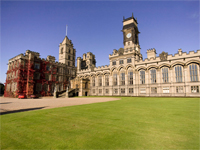
Bathrooms and indoor plumbing were often a great source of inconvenience. Even as late as 1873, such a grand house as Carlton Towers, Yorkshire, had no bathrooms with washing still undertaken via hand-filled basins and hip baths. By contrast, Stoke Rochford Hall in 1839 had fifteen and by 1874 Wykehurst had the then radical innovation of each bedroom being a suite with its own bathroom. A number of country houses were demolished for reasons of inconvenience with a lack of bathrooms often cited, especially as the complexities of adding them to older houses was to prove insurmountable, either technically or financially.
Such challenges were often a catalyst for innovation – particularly if the owner was one of the industrial titans of the age, a man as comfortable in the workshop as the boardroom. Although William Armstrong (b.1810 – d.1900), 1st Baron Armstrong (after 1887), started his professional life as a solicitor he was able to turn his analytical mind to practical challenges as much as legal ones. The genesis of his engineering career stemmed from his love of fishing where he noticed how inefficient waterwheels were and so designed a much more efficient water-powered engine. He successfully showed it could be used to hydraulically power cranes and thus improve the speed of cargo unloading at the docks. This formed the basis for Armstrong’s engineering firm in 1847 and his first fortune. The firm’s greatest fame/infamy came due to the later armaments work which Armstrong had turned to when he read that the British Army had difficulties with heavy field guns during the Crimean War. Success here with his revolutionary design and, later naval versions, led to the creation of a shipbuilding firm which won orders throughout the world, generating his second fortune.
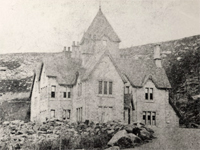
Armstrong’s obviously busy and productive life gave him great status in Newcastle-upon-Tyne and beyond and his main home in the city was a grand, if heavy, suburban creation called Jesmond Dene House. As befitted any Victorian man of wealth and social stature and due to the pressures of running his businesses, Armstrong sought a country retreat. Having visited the Rothbury area as a child, he looked there for a suitable estate, eventually buying in 1863 the then small shooting lodge and 20-acres of land which formed part of a steep-sided valley through which ran the Debdon Burn. Over the next few years, as Armstrong came to reduce his involvement in his businesses, Cragside became a passion; a place to retreat but also to enjoy more domestic challenges with the help of one of the most brilliant architects of the age, Richard Norman Shaw. Armstrong eventually came to own 16,000-acres of Northumberland, including Bamburgh Castle, of which 1,759-acres surrounded Cragside in which he had planted over 7m trees and innumerable rhododendrons.
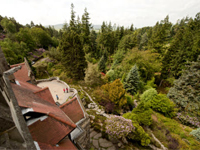
Between 1869-84, Cragside was transformed into a modern Victorian plutocrats palace, but one incorporating all conceivable innovations, powered by his own hydraulic engines. The first challenge was the location, which was ideal for a small lodge but cramped for the house which it eventually supported. The steep hillside meant that space for expansion either had to be created through excavation or by building up the ground. What it lost in convenience, it gained in views; spectacular vistas overlooking the remote Northumberland countryside. Unfortunately, those views – both from and of the house – are now somewhat obscured by some of those same trees planted by Armstrong.
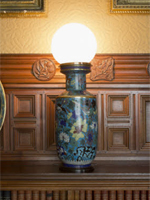
It was inside the house that the inventive mind of both owner and architect could really find effect. For Shaw, Armstrong was an ideal patron, offering none of the conservative reticence he might have found in other clients, able to offer either his innovations or those of his friends. By December 1880, Cragside was the first private house in the UK (and Girouard thinks possibly in the world) to have electric light comprehensively installed, thanks to Armstrong’s friendship with Joseph Swan, with his eponymous filament bulbs throughout. Power for these innovations came from Armstrong’s own hydroelectric engines, running from the Burn below.
With the luxury of his own cheap and apparently limitless power supply, Armstrong and Shaw’s opportunities were myriad. In addition to the lighting, the central heating system was also driven by a hydraulic engine. That same power source also enabled the kitchen to boast a hydraulically-powered spit with the heavy pots in the conservatories moved by hydraulic machinery, with an electric sewing machine and electric communication throughout the house and even out to a shooting lodge on the moor.
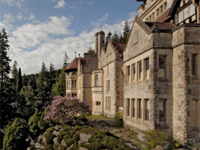
To his contemporaries, Cragside must have seemed beyond ingenious – a place grown from an inhospitable hillside, packed with innovations. The house became a significant marketing tool for Armstrong as visits from his prospective customers, including the King of Siam, the Shah of Persia and the Crown Prince of Afghanistan, gave him the chance to demonstrate the advanced technology they could be buying into, a true theatre of innovation. The Prince and Princess of Wales also visited in August 1884, thus giving the royal seal of approval to such a modern approach to the traditions of the country house.
Cragside passed to the National Trust in 1977, sadly missing the best of Armstrong’s picture collection (sold in 1910), but cared for and open so we can enjoy seeing the products of two great Victorian minds. Despite being the genesis of domestic hydroelectric power, a gas turbine was installed in 1895 to provide more power before being connected to the National Grid in 1945. However, in early 2014, the National Trust is again installing a modern hydroelectric screw to once more generate electricity for the house providing a welcome return of innovation.
———————————————————
Article: ‘Hydro-electricity restoration work starts at Cragside‘ [BBC News]
Official site: ‘Cragside‘ [National Trust]
160+ images: ‘Cragside‘ [National Trust Images]